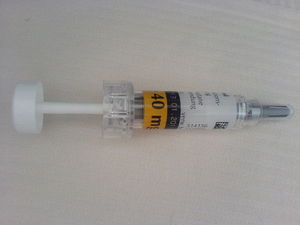Copaxone, also known by the generic name glatiramer acetate, is a brand name prescription drug that treats certain cases of multiple sclerosis. Copaxone is used to prevent or reduce the frequency of relapses of multiple sclerosis. The side effects of Copaxone or glatiramer acetate include anxiety, back pain, chest pain, and joint pain.
Multiple sclerosis is a disabling autoimmune nerve disease that affects more than two million people throughout the world. Copaxone aims to stifle the autoimmune reaction to both increase the time between relapses and fight long-term disability. Copaxone comes in injection form. The shot is typically injected once daily, though dosing can vary from patient to patient. A study by the University of Maryland Medical Center found that the drug reduced the occurrence of relapses by nearly one-third.
The most common side effects of Copaxone or glatiramer are nausea, vomiting, sweating, weakness, and fatigue. According to the UK National Health Service, more than ten percent of users experience chest pain, difficulty breathing, and irritation at the site of injection shortly after using the shot. With this medication, these are often temporary, but medical attention should be sought if they persist or worsen. Other common side effects of Copaxone are back and joint pain, infection, fever, and other symptoms of the flu.
Many side effects of Copaxone or glatiramer can be more serious, requiring a change in treatment or even emergency care. According to the University of Maryland, serious side effects of Copaxone include pain in the back or neck, swollen lymph nodes, flu-like symptoms, severe irritation at the infection site, abnormal bleeding or bruising, skin rash, and pain during urination. Swelling, hives, itching, and difficulty breathing are signs of an allergic reaction and should receive immediate treatment.
The Mayo Clinic reports additional uncommon side effects of Copaxone including blood in urine, high blood pressure, severe headache, weight gain, sores on the mouth or lips, and appetite loss. Copaxone does not have many known interactions with other medications. According to the National Health Service, corticosteroids and highly protein-bound substances may interact with glatiramer acetate. Tell your doctor about any other drugs you use before taking Copaxone.
Copaxone, also known as glatiramer acetate, is a prescription multiple sclerosis medication. Copaxone combats relapses of multiple sclerosis and helps to slow the disease’s progression. The side effects of Copaxone most commonly include nausea, fatigue, back pain, and irritation at the site of injection. More serious reactions can occur. Talk to your doctor about any serious side effects that occur while using Copaxone or glatiramer acetate.
References:
Glatiramer acetate. National Health Service.
Glatiramer (Injection). University of Maryland Medical Center.
Glatiramer (Subcutaneous Route). Mayo Clinic.
New study provides more evidence that Copaxone can slow progression of multiple sclerosis and reduces attacks. University of Maryland Medical Center.




